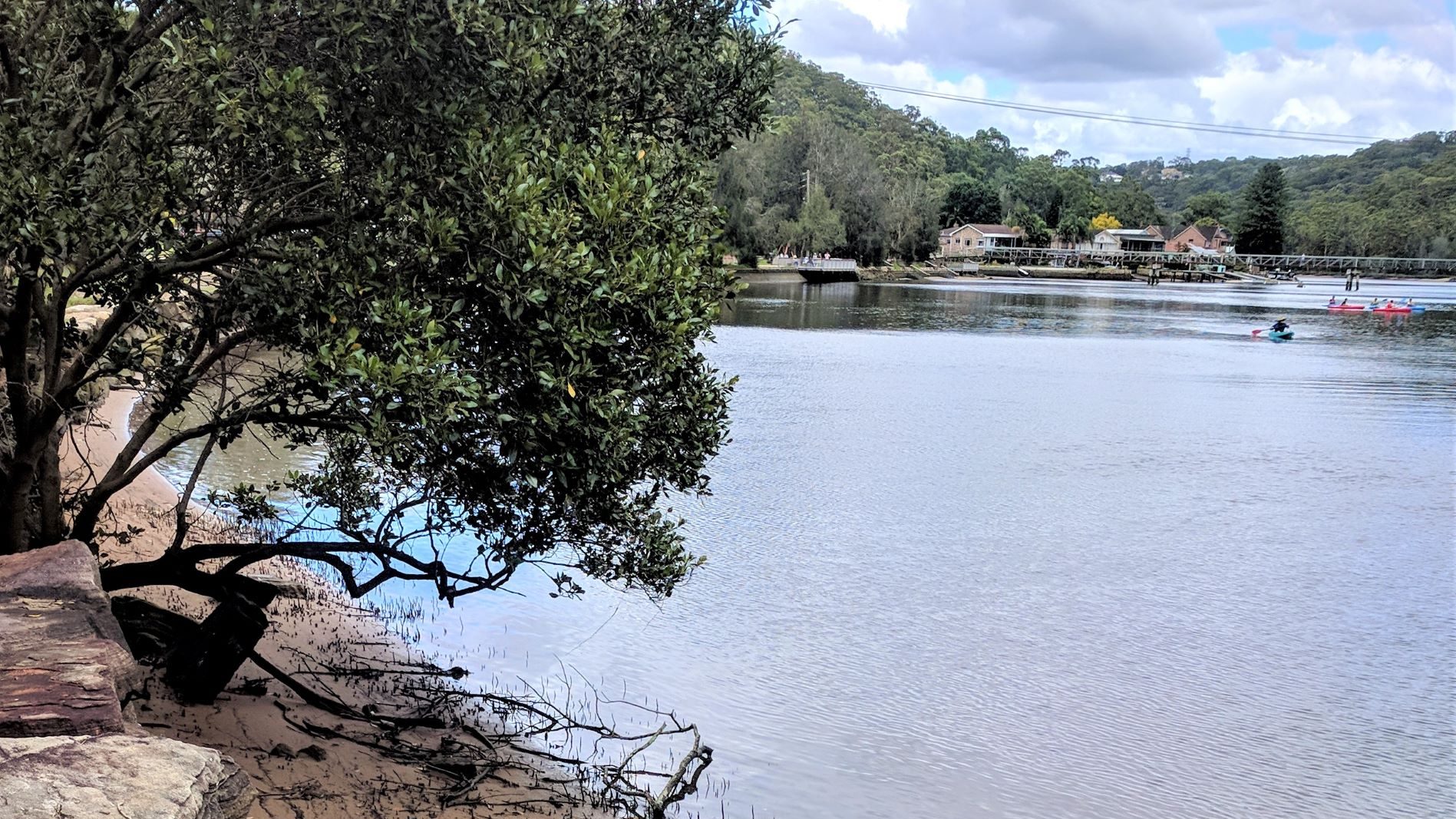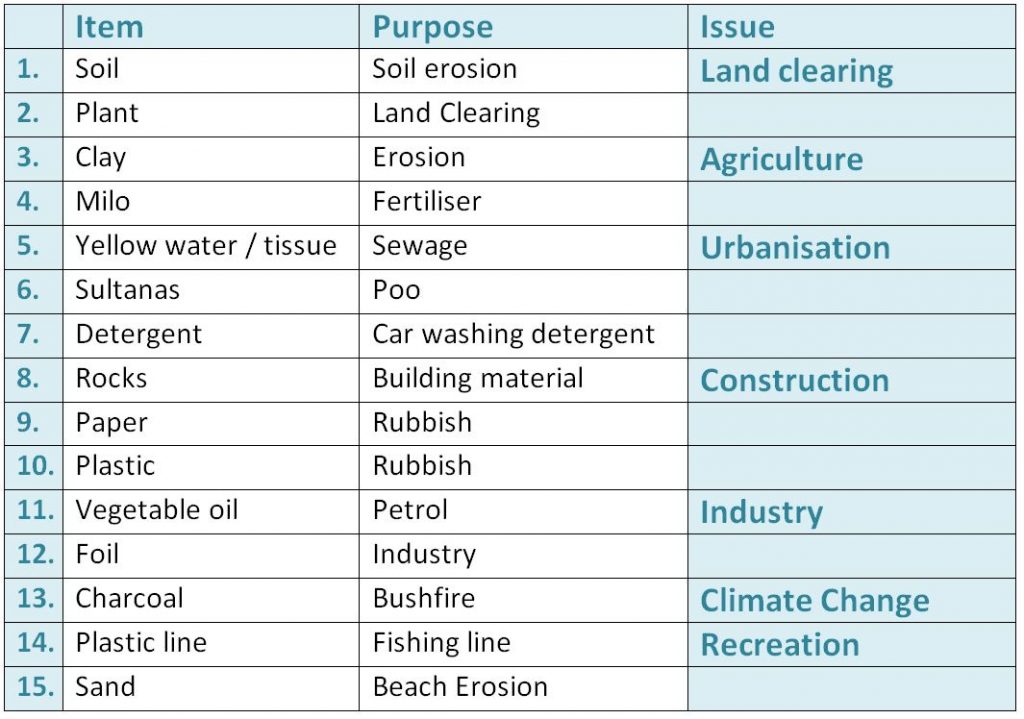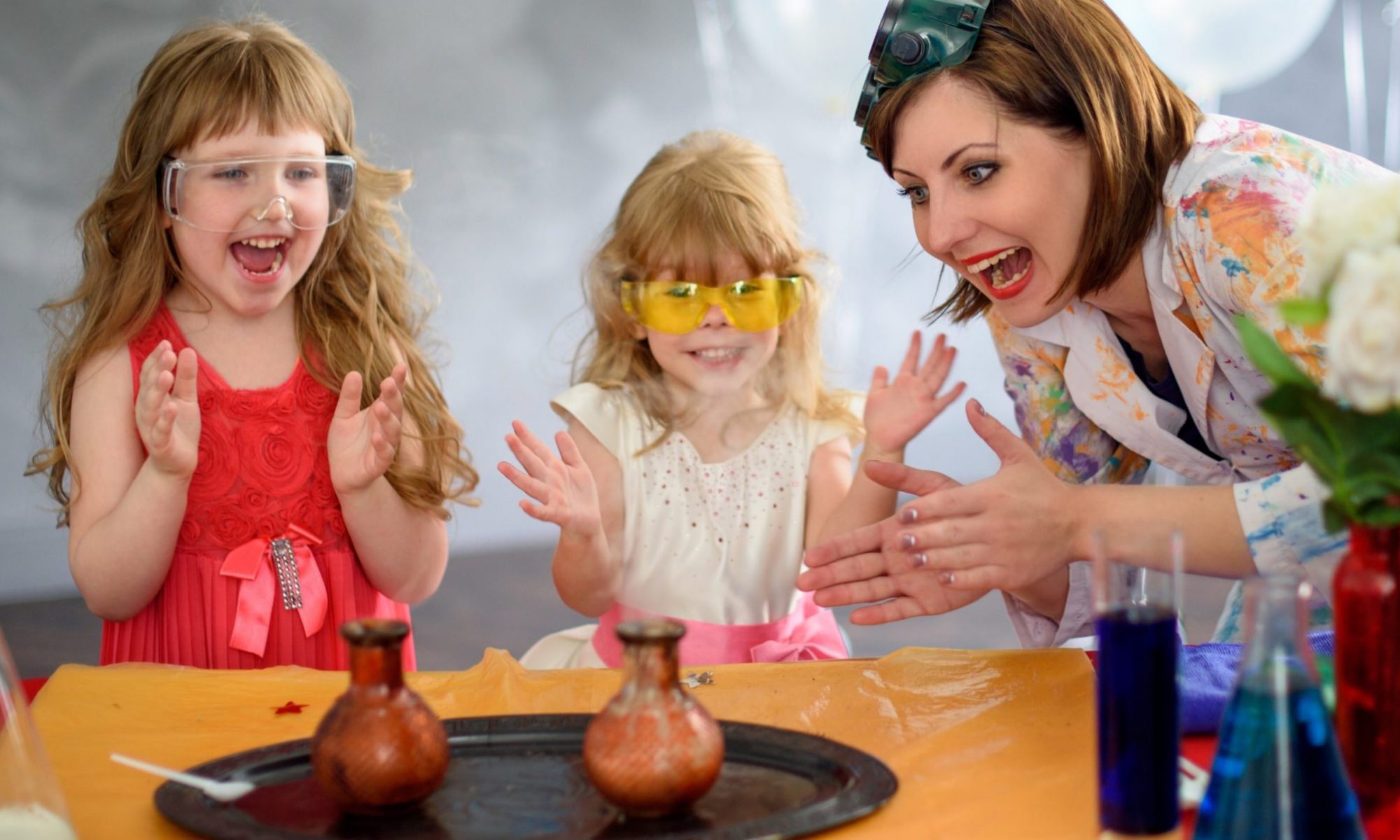Follow the journey of water down the river through the catchment to the sea. Water is essential for all forms of life and the small amount of available freshwater create competing pressures for our water resources. Different land uses in a catchment have different impacts out our precious water resources. Discover the impacts of land clearing, agriculture and urbanisation on our waterways.

Start your story with this exploration of the interactions between the land and sea. Eighty-five percent of Australians live within 50km of the coast. This session looks at the waste that washes downstream in our catchments, the impacts it has on our estuaries, wetlands and coastal areas where the rivers meets the sea.
Set up instructions
There is about 20 mins of set up and preparation required for this activity. It is definitely worth the effort.
Add the items from the table below into separate small jars or containers labelled 1 to 15. You need about a tablespoon of each and you can make substitutions where needed.

Note: you can get your students to help with some of the prep work to reduce time.
Once you have all your containers ready:
- fill a large clear bucket or plastic aquarium with 2 litres of water and place it in the middle of the room or outdoor space.
- arrange your students in a circle around the water container, and hand out the jars or containers.
- introduce the concepts of the water cycle and catchments
- read the following Story of a River or make up your own
- get the kids to add the item in their jar to the container of water.
Inquiry Questions
- What are the changes in the environment over time?
- What happens to the quality of the water on this journey?
Create your own story
You can make your story general or very specific to your local area. Start at time in Australia when there weren’t any cities or towns. Ask the students what they think it would have looked like when Australia’s first people lived on this land.
Australia’s first people lived in a sustainable way and the waterways were healthy, pristine environment. The water was clean and healthy; people were able to drink straight from the streams and rivers. These waterways meant life for people, plants and animals. But over time, new people settled here from all over the world.
Thriving towns and farms of all sizes where build across the country, always sticking close to the waterway because for them too – water was life.
- Trees were cut down to make room for more towns. The ground was bare and when it rained dirt and plant material was washed into the rivers.
- ADD content from jars 1 & 2 into the container of water to represent erosion and land clearing.
- The cleared land was used for livestock and to grow food. The animals made tracks in the dirt when they went to the river to drink
- ADD content from jars 3 into the container of water to represent erosion.
- To help the plants grow fertiliser is used.
- ADD content from jars 4 into the container of water to represent fertiliser running into the river.
- Some houses and towns didn’t have proper toilets and pipes and everything went straight into the river.
- ADD content from jars 5 & 6 into the container of water to represent sewage.
- All the cleaning materials we use in our home and garden were also washing into the river.
- ADD content from jars 7 into the container of water to represent detergents.
- As the number of people continued to grow across Australia there was need for more and more houses and building. Mining helped find the materials for the buildings.
- ADD content from jars 8 & 9 into the container of water to represent mining material.
- People were not always putting their rubbish in the bin and more and more rubbish ended up in our rivers and oceans.
- ADD content from jars 10 & 11 into the container of water to represent rubbish.
- Waste from towns, factories, cars and trucks washes into our rivers too
- ADD content from jars 12 into the container of water to represent oil and chemicals.
- Many areas across Australia were impacted by the bushfires; the rain helped put out the fires but also washed charcoal and plant material into the river.
- ADD content from jars 13 into the container of water to represent burnt bushland.
- People love visiting their local rivers and beaches. These areas are used for fun and enjoyment, like swimming, picnicking and fishing. Sometimes not everything is taken home again.
- ADD content from jars 14 into the container of water to represent recreation.
- Many people want to live near the coast and lots of trees and plants are removed to make room for more houses. This can change the way the sand and beaches move.
- ADD content from jars 15 into the container of water to represent beach erosion.
Use the large wooden or plastic spoon or tongs to stir up the water. Look at what is happening to the water! Just imagine your local river would have looked like and it probably smelled too.
Follow up questions
- What do you think happens next?
- What can we do to stop these things getting in the waterways and the ocean?
The Story continues:
- Students at the local school wanted to clean up the water. As a community they went out to pick up rubbish from the riverbank and beaches.
- Use the strainer to REMOVE the floating pollution.
- Students join up with their local environmental group to plant tree, shrubs and grasses along the river bank and help protect the sand dunes.
- Pour the dirty water slowly through the folded paper towel or filer paper in a funnel to REMOVE the dirt, rocks and sand pollution.
Education resources
Why is Water Important
Water is the most common substance found on earth, so why is it important? Water is essential for all forms of life and can dissolve nearly anything. It can exist as a gas (water vapour and steam), a liquid (water) and a solid (ice).
The Natural Water Cycle
The natural water cycle shows the constant movement of water around the world. Water moves through the processes evaporation, transpiration, condensation, precipitation, run-off, infiltration and percolation.
The Urban Water Cycle
The natural water cycle has been modified by people to ensure a constant water supply and the safe disposal of wastewater. The Urban Water Cycle incorporates the Water Supply System, Wastewater system and the Stormwater system.
How to be Waterwise
Water is essential for all life and is the most abundant substance on Earth, yet water scarcity is one of the biggest issues facing us today. Australia is the world’s driest inhabited continent and 2019 was the hottest and driest year on record.

